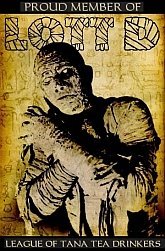Zombos Says: Very Good
Carreras was a charismatic salesman, and the only British producer to strike distribution deals with every major American studio. He was often able to do this without a script or the promise of major stars, but he rarely went into negotiations without provisional poster artwork and a title. (from the Introduction, The Art of Hammer)
Let's be clear: the art in Hammer Studios' movie posters is promulgated on crass commercialism and designed toward a preponderance of lurid, gamy imagery, and deplorable subject matter. Thank the lord all of this sordidness is captured in Titan Books The Art of Hammer, a necessary reference for that studio's movie poster art, which was created when posters really mattered for whetting the appetites of production backers and selling theater seats.
With no Internet viral campaigns, no chit-chatty forum quorums, no message board hype, and certainly no social networking picky-pecking, blurby-wordies to sell a movie, Hammer's artists combined bold imagery, screeching colors, and pow-zam-boom verbiage to titillate the vulgar interests of movie goers, stimulate the monetary interests of distributors, and annoy everyone else enough so they took offense and complained, providing even more word of mouth promotion.
Movie poster art became a passion of mine starting around 1968, when, in a small Hawaiian theater showing The Love Bug I saw a hand-painted poster for the movie in the lobby. Now, before you wonder why anyone would do a hand-painted poster for thatmovie (or whyI would go and see it), I'll cut you short and tell you to focus instead on the word hand-painted. Maybe they didn't have enough printed posters to go round, or maybe they couldn't afford more than a few, but whoever did the painting knew exactly what a movie poster needs to do. That person copied the print poster but made it more fun, more vibrant, so Herbie jumped out at you as you walked past, exclaiming "you must see me in this movie!" That's when I realized how important movie poster art really was, and still can be, once you look past the lenticular novelties and static photographic ensembles posturing for your attention in the theater lobby today.
Marcus Hearn (Hammer Glamour) returns to annotate an array of horror, comedy, potboiler, and exploitation posters that scream "you must see this Hammer movie!" beginning with 1950's screen-printed The Dark Light, and continuing up to 1979's The Lady Vanishes. Not all of Hammer's movies are represented due to lost artwork, but what's here is a grand sampling of styles and artifice. Hearn points out the prevalence of victimized and terrified women in posters that began in earnest with the Gothic Horror offerings. Up until then, men and women are shown together (usually embracing), or a dramatic depiction of action from the movie comprised the composition; afterward, it's mostly women and monsters in various postures of terrified and terrorizing hawking the movie, with American poster versions usually rendered more sensationally. Indeed, much of the fun in viewing these posters comes from comparing the British, American, Spanish, German, and Belgian versions for the same movie, each doctored to the acceptable (or barely tolerable) limits allowed by that country's standards.
Movie posters are arranged by decade and Hearn adds brief comments here and there explaining important changes in style and provides notes on the artist or artwork involved. My favorites are, of course, the mix of horror's vampires, mummies, and Frankenstein Monsters. They fostered an artistic expression leading to interesting interpretations, such as The Mummy's title monster having a gaping hole in its chest through which a pursuing bobby's flashlight shone through:
"The Mummy was still in production when Peter Cushing first saw Bill Wiggins' painting. Concerned that it misrepresented the film, Cushing asked director Terence Fisher if he could add a scene where his character drove a harpoon through the mummy's body."
The influence of pop art can be seen in the 1970s as more psychedelic colors and groovier layouts kick in, eventually followed by more photographically oriented compositions to trim the budget. Surprisingly, I never noticed the phallic inferences Vic Fair drew into the British Vampire Circus poster until Hearn pointed them out. How that got passed through the stringent British Board of Film Classification is a wonder.
If I were pressed to find one fault in The Art of Hammer, it would lean toward a preference I have. All posters are oriented in portrait, which does make the book easier to browse through. Given its coffee table size I agree it would be a bit of a bother to swing the book from portrait to landscape orientation to view posters, but some posters that would easily fill a full page in landscape view are short-changed by presenting them in the smaller, portrait view. Nonetheless, I recommend this as a superb horror fan gift to give or to get. It's naughty and nice and filled with spice.

 A courtesy copy of The Art of Hammer was provided by Titan Books for this review.
A courtesy copy of The Art of Hammer was provided by Titan Books for this review.








